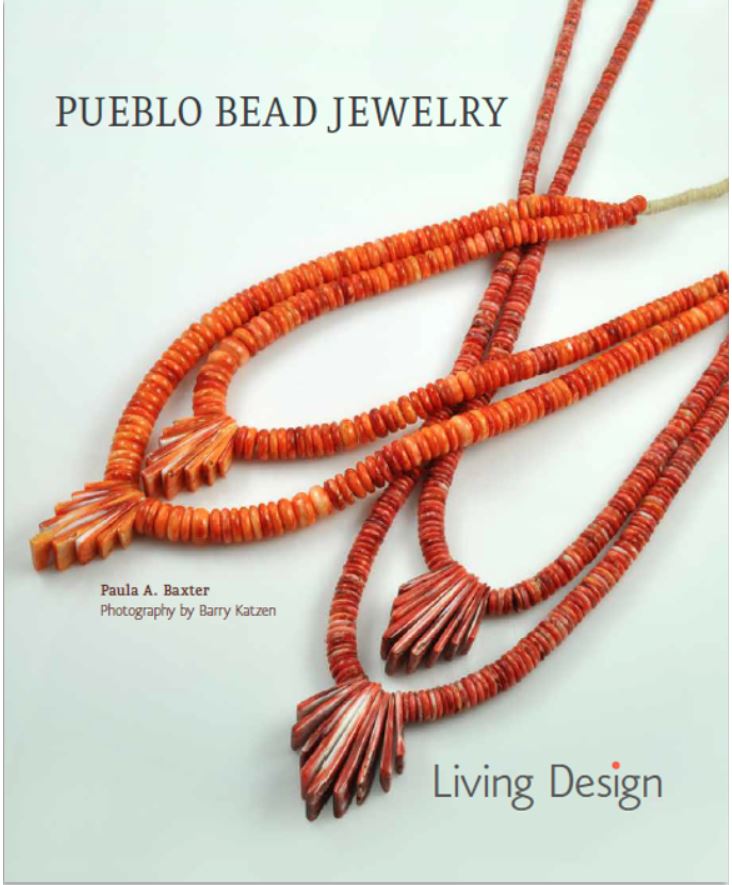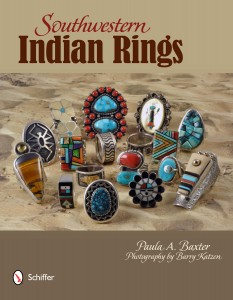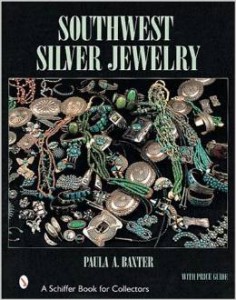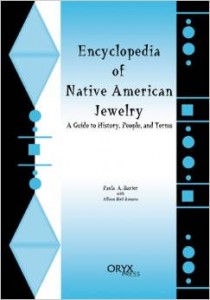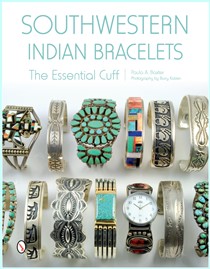Looking over the winning entries for the juried competition award list for the 2012 Heard Museum Guild Indian Fair and Market, I see some titles that inspire chuckles and giggles. I’ve always enjoyed the sly nature of Indian humor, from Fritz Scholder to Diego Romero. A people who have decried their stereotyping often prove resilient in gaining revenge. Some of the winners of this year’s competition have had no compunction about mocking our contemporary society and its obsessions:
- Best of Class for Classification IV Wooden Carvings was “Techno Kid on the Run” by Stetson Hunyumptewa. A Hopi koshare pursues a naughty boy who is preoccupied with his smart phone and apps.
- In the non-traditional Baskets Classification, Pauline Tsosie produced a delight entitled “Paradigm Shift.”
- Two winners in the Mixed Media Classification were titled “Vexations” and “Power Struggle,” reminders that the days of “Bambi School of Art” prettiness are resoundingly rejected.
Will it be true that our 21st century is known as “The Age of Cynicism” by Natives and non-Natives alike?

We are rabbit owners and totally besotted over our pets. American Indians have a much more guarded view of these furry mammals. Rabbits are largely prey animals, and we realize this while admiring the beauty of handmade Hopi rabbits sticks. Rabbits aren’t worthy enough to be part of the six directions or serve as serious hunting fetishes. Nor do any Pueblo cultures salute them as possessing katsina-like characteristics. Nevertheless, Indians do understand one essential thing about rabbit nature. They are tricksters, not unlike Coyote. Rabbits do creep into some of the old tribal stories.
Back in the late 1980s we hit beginner’s luck and discovered a weaving of domestic rabbits by the great Navajo weaver Fannie Pete, known for her remarkable animal depictions. From time to time, rabbits pop up as motifs on jewelry and other Native arts. Navajo folk art depicts them as comical creatures, and then there is the classic children’s book, Ten Little Rabbits, with its cover of rabbits snuggled into Navajo serapes…
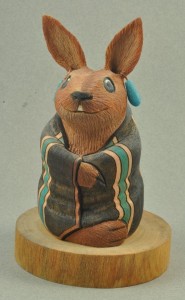 “Rabbit Boy” by Lansing – the perfect example of the trickster rabbit in Navajo folk art.
“Rabbit Boy” by Lansing – the perfect example of the trickster rabbit in Navajo folk art.
I’ve watched this fair since I started attending in the early 2000s. I’d grown a little tired of the Santa Fe Indian Market and a chain of personal challenges made the direct flight from NY’s JFK to Phoenix’s Sky Harbor Airport a more viable choice. Initially, the Guild Fair had a tone of merriment not unlike a large crafts fair. A closer look, however, indicated that the goods on offer were much more than clever craft work. The grounds of the Heard Museum make for a good-natured, self-contained environment. The most notable thing I saw at once was that this show can be a more productive learning experience for the beginning collector. The SWAIA Indian Market is still the place for razzle-dazzle entries, high prices, and reputation-enhancing work. Yet, the arts that are displayed at the Heard show are often things that one call fall in love with quite easily. This year’s Guild Fair opens Saturday, March 3 and runs through Sunday.
We will be taking in the festivities that lead up to the Heard Museum Guild Indian Fair and Market on March 3-4.
Prior to that, I will be signing copies of Southwestern Indian Rings during the Scottsdale Art Walk on March 1. I am dividing my time between two locations:
Old Territorial Indian Arts at 7077 E Main St, from 5 to 7 p.m.
Waddell Trading Company at 7144 East Main Street, from 7 p.m. to 9 p.m.
These two shops are among my favorite destinations in Arizona, and they represent two aspects of the fine Indian art to be found in Scottsdale:
Old Territorial is the oldest running Indian arts shop in the Valley of the Sun. Alston and Deborah Neal offer vintage and contemporary Indian arts that reflect the sturdiness of traditional Native design.
Waddell Trading Company contains dazzling works in rich materials by some of the very best contemporary artists working today. You will see pieces that offer a virtuoso twist on the traditional or avant-garde items that foretell the directions Native style will take.
The creation and launch of the Institute of American Indian Arts (IAIA) in 1962 was an initiative of the Kennedy administration. The first American Indian college devoted to art, it was given a home in Santa Fe—a logical location in terms of the city’s appeal as a marketplace for Indian arts. The famous Indian Market, held there every August, had been started in 1992. IAIA started out with a stellar teaching faculty, including the likes of Lloyd Kiva New and Charles Loloma. One of the most important things that the school fostered was the concept of a shared identity among Native artists; you were connected not just by your tribal ties but your larger communal status as one of America’s first peoples.
The American educational system has been accused of many sins over the years. One sad misrepresentation takes place during the teaching (in eighth grade in New York State and in similar grades in other states) about American’s indigenous peoples. Teachers and textbooks still place a great emphasis on the nineteenth-century history of Indians. The result has been twofold: an admiration for the Native of the past, not the present; and a desire for beautiful artifacts from that past, such as Plains Indian regalia.
Hollywood, and now television, has amplified that misplaced admiration. That’s why everyone has seen Dancing with Wolves over and over, while quieter but more realistic classics like Smoke Signals or Powwow Highway are overlooked. One huge irony I find whenever visiting Indian Country is that there’s always a western playing on local television, and the Indians are usually Navajos dressed up to look like Comanches.
While we have come a long way societally since the first half of the twentieth century, many people still have outdated or unrealistic notions about how American Indians live and think. Part of the problem is that Indians are a genuine minority, representing just under 1% of the American population. Unless one lives close to an Indian reservation, this ethnic group often fails to register in the collective consciousness of our popular culture. Nor do we have television programs, major movies (other than westerns), or celebrities who represent our indigenous peoples. Another large problem has to do with our educational system. American Indians figure in many secondary students’ social studies curricula; usually, this examination looks back to older times and features Indians in clothing and situations that belong to the nineteenth century. No wonder many people, including Europeans, come to Indian Country with rather fantastic expectations. They want buckskin and feathers when they should look for denim and cellphones.
Expect to hear this combination of words more often in the future. A number of the younger and hipper Native artists who dazzle attendees of Indian Market are putting together events that showcase fashion and accessory trends. Their offerings are a natural offshoot of an enduring trend that matches ethnic design creativity with contemporary flair. Frankly, such a movement is quite understandable considering that the Institute of American Indian Arts (IAIA) is celebrating its half-century mark. The under-40 Native artists have had greater exposure to college educations and popular culture that runs 24/7 images. Check out these events when they come to an upcoming Indian arts show. What’s termed avant-garde today will be considered innovative reality tomorrow. All in all, the future’s so bright “I gotta wear shades.”
There are places we haven’t been in the Southwest that call to us from time to time. Rainbow Bridge, located in a remote part of the Navajo Reservation, is one of those places. When I stay in Four Corners I often gaze out north and west and vow to get there some day. Rainbow Bridge is best accessed by Lake Powell, and is a standard stop on the boat rides one can get as a tourist. The eminent anthropologist Clyde Kluckhohn wrote a travel account in 1927, To the Foot of the Rainbow, which was reprinted by the Rio Grande Press. Author Zane Grey, who knew and loved this part of the world, honored the bridge in his western The Rainbow Trail (1915).
For those who’d love a wilderness trail challenge, get a Navajo guide, and plan an expedition: Rainbow Bridge lies half-way between Glen Canyon Dam and Navajo Mountain. The rest of us will get there by boat one day, and Page is a rather nice destination in itself.
